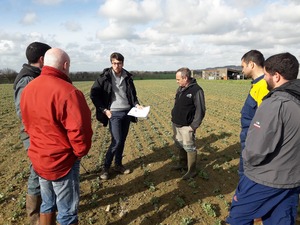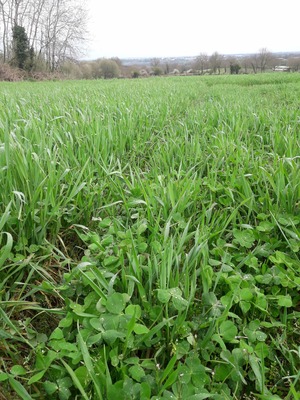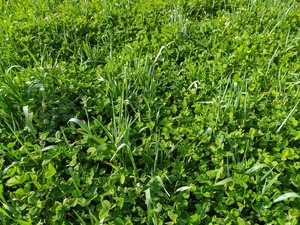Case study 11: France: Co-design of diversified systems in Pays de Loire
Cluster 3: Crop diversification in systems from Western Europe
From innovative system experiments in the area, three major conclusions were drawn to reduce the use of inputs and to improve the economic and environmental sustainability of cropping systems:
- breaking current rotations,
- involving all actors along the value chain as well as scientists, and
- integrating farmers to make changes in cropping systems work.
Crop diversification was seen as a solution for deeper changes.



What were the main problems underlying the emergence of the case study?
In the area, the need to diversify is really important. Cereal producers have to change their rotations to include more sustainable crops (such as leguminous plants) and to make them more financially viable. For breeders, the problem is the dependency on the global market, which pushes them to purchase soya from Brazil for instance, with a really high carbon impact and other hazardous effects.
The case study was initiated based on these conclusions by the Chambre d’agriculture des Pays de la Loire (CRA-PdL) in 2016, during the first meetings with the French partners of the DiverIMPACTS consortium. This case study focuses on a new value chain: selling between farmers. This new value chain needs to be tested to determine the advantages and disadvantage for farmers, but also for the territory. In order for it to be successful, farmers also need to be able to engage and develop connections with a broad network of actors throughout the territory. The case study aims to address these issues.
How was the problem addressed and which actors were involved?
Farmer groups steered by the local Chamber of Agriculture are interested in the goal of improving the economic robustness in their systems. Based on previous experiments, it was determined that there is a need to diversify the rotations. The main challenge with diversification is to find a value chain that is economically viable.
The case study has fostered the collaborative dynamic between farmers and other actors, such as advisors from the Chambre d’agriculture, technical institutes and farmer groups. It also integrated other actors such as the water agency and companies from Vendée. Economic issues are the main motivation for the actors involved in the case study.
Solution investigated
It has become obvious that deeper changes need to be introduced to make the system more robust to economic and climatic hazards.
Specific attention has been paid to the agronomic context and environmental constraints in order to foster the natural regulation of pests, diseases and weeds, as well as to implement a low-pesticides strategy, increase soil fertility and limit the use of mineral fertilizers. That’s why the Chambre d’agriculture des Pays de la Loire participated in this project: to help farmers in this diversification process.
Moreover, there is a desire to increase exchanges between farmers, by opening the group to other farmers who want to diversify. That’s why the advisors from the Chambre d’agriculture have developed, for example, an initiative called “bouts de champs”, which includes meetings with farmers in order to hear from them and talk about diversification in the field. The initiative also aims to find indicators to show farmers the benefits of diversification and that local partnership will help spread those practices in the area.
Expected outcome
The most pressing issue related to crop diversification, is supporting farmers in the cultivation and development of protein crops, or crops with high added value. The search for protein autonomy within farms is a growing demand, particularly in the face of a demand for non-GMO proteins.
To meet this need for protein, some livestock farmers wish to start growing crops with high protein value (soya, lupin, alfalfa, etc.) themselves. In this case, support is necessary. Others, who do not have the time or the technical know-how, are looking for cereal farmers who have mastered these highly technical crops.
There is also the issue of the added value of the final product. How can a non-organic farmer add economic value to their product (milk, meat, etc.), which was produced using proteins from their own farm or a neighbour's? If livestock farmers do not receive economic compensation for integrating local proteins in their rations, this model will probably not be sustainable unless they were to transition to organic farming or change the farming system towards forage and protein quasi-autonomy. This economic compensation could come from the public authorities, a change in agricultural policy or the establishment of a local territorial industry or a specific label for example.
The case studies therefore worked to expand the practice of cooperation between farmers to a bigger scale, through the monitoring and evaluation of already existing partnerships in order to communicate these results to a wider group of farmers.
Relevance to the DiverIMPACTS goals?
The DiverIMPACTS project design gives the opportunity to accelerate the case study dynamic and to expand it by including scientists and education institutions (ESA Angers, Agro-Campus Ouest and INRAE).
Exchanges with other case studies looking at partnerships between farmers, can enrich our reflection and project management. Through this, it has been interesting to reflect and exchange ideas on:
- How to create added value for farmers engaging in exchanges/collaboration?
- How can we deal with the agricultural evolution towards fewer and larger scale farms, but still promote collaboration for crop diversification?
Case study legacy
The partnerships established between farmers will continue and we will continue to provide support regarding the products harvested and exchanged, in order to have the fairest exchanges possible. Furthermore, the current situation (war in Ukraine, etc.) is disorienting the markets and in particular the supply of raw materials for livestock farmers. This new context presents possible opportunities for the case study: can local supply, based on partnerships between cereal farmers and livestock farmers, be strengthened? Can these be considered as a sustainable solution?
Three key lessons stand out strongly in this case study:
- The mix of farming systems in an area provides opportunity for local markets. Indeed, the neighbouring livestock farmers who require protein in particular, allow cereal farmers to diversify their crops by offering a local market.
- This local outlet for the cereal farmer has the advantage of being relatively sustainable over time. Indeed, existing partnerships between farmers have been found to last over time. There are several criteria that are key to successful exchanges (figure 1). The case study highlights the importance of the so-called "social" criteria in relation to the "technical-economic" criteria in the initiation and subsequent sustainability of exchanges. The three most important criteria are trust, transparency and mutual interests (see figure 1). In addition, there are shared values, i.e. shared visions of agriculture held by the cereal farmer and the livestock farmer. Secondly, the exchange, in the minds of the farmers, does not have to be profitable at all costs once it has been set up. Of course, the financial gain will make it possible to consider renewing it in subsequent years. But what will promote sustainability is the notion of mutual interest.
- Finally, the obstacles to trade and to diversification seem stronger on the part of livestock farmers, in particular because they lead to a profound change in the farming system. For example, it can lead to changes in feed ration, distribution, and even a drop in milk production. There are still some issues: how can livestock farmers more easily integrate protein crops cultivated by local cereal farmers, into dairy cows rations? And how can livestock farmers get more value from their products, from local feed, from partnerships with cereal farmers?

Further information
Links
- youtube.com: Video about Co design of diversified cropping system in Pays De La Loire - Case Study 11 DiverIMPACTS
- pays-de-la-loire.chambres-agriculture.fr: DiverIMPACTS : un projet pour des systèmes de culture durables
- Article: “Perspectives Agricoles”
Case study team
- Jérémy Berthomier, CA PdL (APCA), case study leader
- Emmanuel Mérot, CA PdL (APCA), case study monitor
 tap and then scroll down to the Add to Home Screen command.
tap and then scroll down to the Add to Home Screen command.